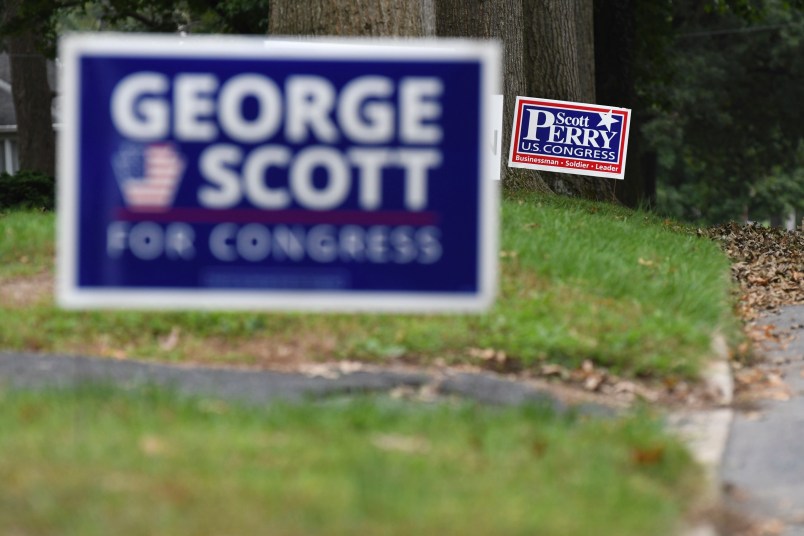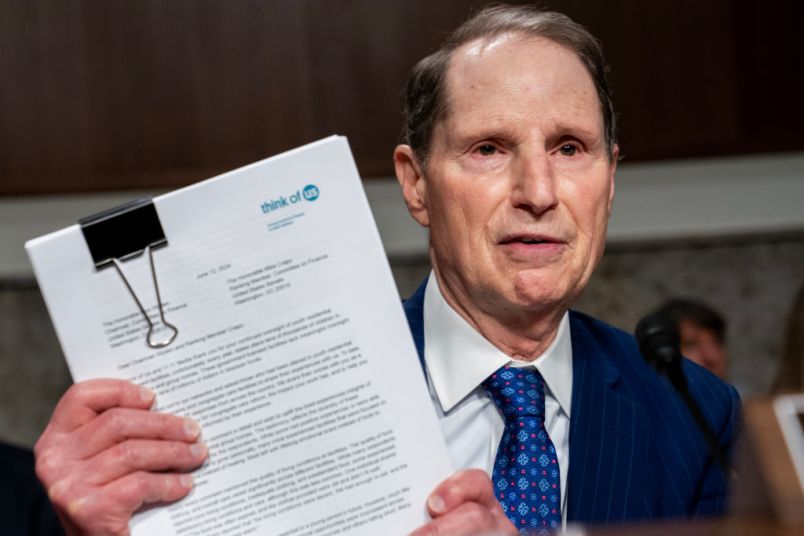HARRISBURG, Pa. (AP) — Scott Perry has won his conservative district by no fewer than 25 percentage points on his way to three terms in Congress, but a sweeping redraw of Pennsylvania’s House district boundaries has forced several Republican congressmen into newly competitive seats, Perry as much as anyone.
Now, Perry — a member of the Freedom Caucus, a particularly conservative group of House Republicans — is battling for his political life in conservative central Pennsylvania, and the state has emerged as a keystone for Democrats aiming to recapture a House majority.
George Scott, the Democrat challenging Perry, is a first-time candidate and Lutheran pastor who, like Perry, served with the Army in Iraq. Democrats like Scott’s chances enough that the Democratic Congressional Campaign Committee is dropping $260,000 into the race to attack Perry on TV.
On Saturday, Scott greeted canvassers at a suburban Harrisburg gathering where people buzzed about a poll showing a neck-and-neck race, then sped off for a pancake breakfast and a booth at a pumpkin festival.
“This is how we’re going to win, through days like today and through people like you,” Scott told canvassers.
January’s ruling by the state Supreme Court’s Democratic majority threw out 6-year-old district maps drawn and approved by Pennsylvania’s Republican-controlled Legislature and Republican governor, saying they were unconstitutionally gerrymandered.
It tore up decades of precedent in how districts were drawn in a bid to elect as many Republicans as possible, and it succeeded. Republicans won 13 of 18 congressional seats on that map in three straight elections in a state where Democrats hold a registration advantage and won 18 of 24 statewide elections during that period.
After Democratic Gov. Tom Wolf and the Legislature’s Republican majorities didn’t agree on a replacement map, Democrats on the court imposed one . The new map repackages elongated and bent districts and reunifies Democrat-heavy cities that had been split by Republican map drawers.
November’s midterm election is expected to dramatically change Pennsylvania’s delegation, especially after several Republican congressmen decided against running again amid a hostile political environment.
The new districts are expected to yield something closer to a 9-9 tie. If Democrats win every seat on their battlefield map, they’ll capture 12 total seats and wipe out nearly one-third of the 23-seat Republican majority.
The races are largely along national themes, and Perry and Scott attack each other as too extreme, insincere about bipartisanship and hiding their true beliefs.
“My opponent doesn’t want anybody to know what he’s about,” Perry told dozens of Republican Party canvassers on Saturday. “He wants them to see him in uniform, and go, ‘Well, that guy is almost like Perry; heck, his name’s almost the same.’ Well, that’s what he wants. We must tell them, ‘It’s a vision of two different futures.'”
Scott contends that Perry is trying to reinvent his voting record and rattles off a list of Freedom Caucus greatest hits: government shutdowns in 2011 and 2013 and blocking of immigration and farm legislation.
“People are sick of the divisiveness, they’re sick of the extreme partisanship, they’re sick of groups like the Freedom Caucus, which seeks to divide us rather than unite us,” Scott said at a forum Friday.
Perry owns the most conservative voting record in Pennsylvania’s congressional delegation, according to American Conservative Union ratings, and has among the most conservative voting records in the House.
The district Perry represents has roughly 60,000 more registered Republican voters than Democrats, and Donald Trump won it by 21 percentage points over Democrat Hillary Clinton in 2016’s presidential contest.
The new district has a slimmer Republican registration advantage of 25,000 and, had it existed in 2016, Trump would have won it by a more modest 9 points.
About 40 percent of the district is new to Perry.
When he goes door-knocking in a new portion of the district, Perry said, he introduces himself to a prospective voter, explains that Pennsylvania’s districts have changed and that now he’ll be on their ballot. He then asks if they have any questions.
It doesn’t always go well.
“I’ve got a plenty of questions, a plenty of questions,” one woman, a registered Democrat, told him at a driveway sale in a suburban Harrisburg neighborhood Saturday. “We’ve got to start in Washington; we’ve got to clean that up. That’s embarrassing.”
Perry acknowledges that he’s in a newly competitive seat and that he’s working harder than ever to raise money; several conservative groups have reported spending more than $200,000 to help him, including a new TV ad by Heritage Action for America.
But Perry said he doesn’t need to change how he votes to fit a changed district.
“We all want safe communities, lower taxes, an efficient government, affordable and accessible health care; we want government to keep the promises that it made for our seniors,” Perry said. “That’s universal; it doesn’t matter where you live. It’s just getting the message out.”










The article so nice they published it twice.
But in GA…
https://www.huffingtonpost.com/entry/georgia-voting-rights-brian-kemp-stacey-abrams_us_5bbe435fe4b0876edaa4d908
https://www.youtube.com/watch?v=CYeKAMrkneMedit: daiyl show looks at the GA race a bit